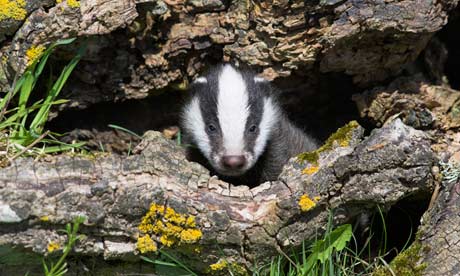Badger TB cull: will the zero-cost, zero-sense policy prevail?
It's B-day for badgers, with environment secretary Caroline Spelman presenting her culling plans to cabinet. But has she solved the policy's fatal flaws?

Many thousands of badgers would be culled under government proposals. Photograph: Steve & Ann Toon/Corbis
Today, if you will, is B-day for badgers. The environment secretary Caroline Spelman will present her vastly delayed decision on whether and how to cull badgers in England to the cabinet. The aim of the measures to reduce the bovine tuberculosis that has ravaged cattle herds in England for many years. She looks likely to back a cull, which will be hugely controversial.
Spelman's positions is unenviable. She faces the farmers' shotguns on one side and the fury of animal rights campaigners on the other. But it is of her own making: accepting the biggest budget cut in Whitehall has left her with no money to pay for a sensible solution.
Instead, the proposals consulted upon by the government, amount to a DIY cull by landowners: they will self-organise into groups and then shoot free-running badgers. At the time, the proposals were described as "scientifically among the worst options they could have chosen" by the leading UK's leading badger ecologist, who worked on the biggest trial ever undertaken.
The first flaw is a big one: no-one knows if the proposal will actually work. That's because the free-shooting of badgers was not tested in the 10-year trial. Instead, the animals were first trapped and then shot, a more expensive method. Another flaw is that there was no mechanism proposed to ensure that the culling is coordinated and maintained over large areas for at least four years. If that does not happen, then "peturbation" - badgers fleeing sporadic killing - spreads TB further, worsening the problem.
The last flaw I will mention is that while the cull is zero-cost to the government, it is expensive for farmers. So expensive in fact, the consultation itself shows, that it outweighs the cost TB outbreaks incur on farms. That gives an incentive to abandon culling halfway through if money is short.
Let me be clear at this point: TB in cattle takes a huge emotional and economic toll on farmers. It is getting worse and has cost the taxpayer about £500m in compensation in the last decade. Something must be done.
The coalition agreement pledges a "science-led policy of badger control in areas with high levels of bovine tuberculosis". So let's take a look at the conclusions on culling reached by one of the most eminent panels of scientists you are ever likely to see, released this week by Defra.
On the issue of culling method, the panel led by Defra's chief scientist Bob Watson and the chief vet Nigel Gibbens, noted:
Informed expert opinion suggests that the more that a future culling policy deviates from the conditions of the [10-year trial], the more likely it is that the effects of that policy will differ, either positively or negatively, and with potential variability in outcome between areas.
On the need for coordinated, extensive and long-term culling:
If culling is not conducted in a coordinated, sustained and simultaneous manner according to the minimum criteria, then this could result in a smaller benefit or even a detrimental effect on confirmed cattle bTB incidence. [NB the minimum criteria are defined as: covering at least 70% of the land within the culled area, a minimum area of 150km2, sustained for a minimum of four years, and conducted simultaneously as defined as within a six-week period each year.]
So, if this culling programme is carried out successfully in one area, what would be the benefit? Somewhere between 8% and 24% reduction in TB in cattle after nine years, say the experts.
And could culling deal with the national problem?
In order to have a significant impact on national disease incidence, culling would need to be conducted over a very large area (bTB is currently considered endemic in over 39,000km2 of England). The associated impact of culling at this scale on the national badger population is unknown.
So could culling at a scale necessary to deal with bovine TB wipe out British badgers? They don't know.
Those are the problems and we will have to wait and see whether Spelman has found solutions to them. The most obvious alternative is already being implemented by the National Trust: trapping and vaccinating the badgers against TB. But, it's expensive and the government has cancelled five projects to test vaccination, leaving just one.
In the medium-term, an oral vaccine, which can be given far more easily and cheaply in food, seems ideal. But will not be ready for use until 2015. In the meantime, five months after the decision was due, we will see whether Spelman has made sense out of the nonsensical proposals.
http://www.guardian.co.uk/environment/damian-carrington-blog/2011/jul/07/badger-cull-cattle-tb-farm-shooting











No comments:
Post a Comment